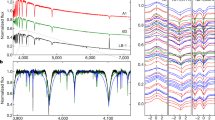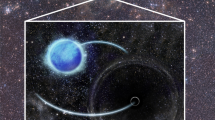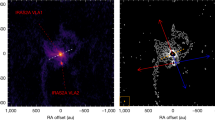Abstract
A close but newtonian encounter between a tightly bound binary and a 106 M⊙ black hole causes one binary component to become bound to the black hole and the other to be ejected at up to 4,000 km−1. The discovery of even one such hyper-velocity star coming from the Galactic centre would be nearly definitive evidence for a massive black hole. The new companion of the black hole has a high orbital velocity which increases further as its orbit shrinks by tidal dissipation. The gravitational energy released by the orbit shrinkage of a such a tidal star can be comparable to its total nuclear energy release.
This is a preview of subscription content, access via your institution
Access options
Subscribe to this journal
Receive 51 print issues and online access
$199.00 per year
only $3.90 per issue
Buy this article
- Purchase on Springer Link
- Instant access to full article PDF
Prices may be subject to local taxes which are calculated during checkout
Similar content being viewed by others
References
Oort, J. H. A. Rev. Astr. Astrophy. 15, 295–362 (1977).
Hills, J. G. Nature 254, 295–298 (1975).
Hills, J. G. Mon. Nat. R. astr. Soc. Soc. 182, 517–536 (1978).
Hills, J. G. & Fullerton, L. W. Astr. J. 85, 1281–1291 (1980).
Shampine, L. F. & Gordon, M. K. Computer Solution of Ordinary Differential Equations: The Initial Value Problem (Freeman, San Francisco, 1975).
Aarseth, S. J. & Hills, J. G. Astr. Astrophy. 21, 255–263 (1972).
Heggie, D. C. Mon. Nat. R. astr. Soc. 173, 729–788 (1975).
Hills, J. G. Astr. J. 80, 809–825 (1975).
Sellgren, K., Hall, D. N. B., Kleinmann, S. G. & Scoville, N.Z. Astrophys. J. 317, 881–891 (1987).
Hills, J. G. Mon. Nat. R. astr. Soc. 175, lp–4p (1976).
Benz, W. & Hills, J. G. Astrophys. J. 323, 614–628 (1987).
Author information
Authors and Affiliations
Rights and permissions
About this article
Cite this article
Hills, J. Hyper-velocity and tidal stars from binaries disrupted by a massive Galactic black hole. Nature 331, 687–689 (1988). https://doi.org/10.1038/331687a0
Received:
Accepted:
Issue Date:
DOI: https://doi.org/10.1038/331687a0
This article is cited by
-
Monthly quasi-periodic eruptions from repeated stellar disruption by a massive black hole
Nature Astronomy (2023)
-
Faint objects in motion: the new frontier of high precision astrometry
Experimental Astronomy (2021)
-
Proof of the classical soft graviton theorem in D = 4
Journal of High Energy Physics (2020)
-
Rates of Stellar Tidal Disruption
Space Science Reviews (2020)
-
The mass of our Milky Way
Science China Physics, Mechanics & Astronomy (2020)
Comments
By submitting a comment you agree to abide by our Terms and Community Guidelines. If you find something abusive or that does not comply with our terms or guidelines please flag it as inappropriate.



